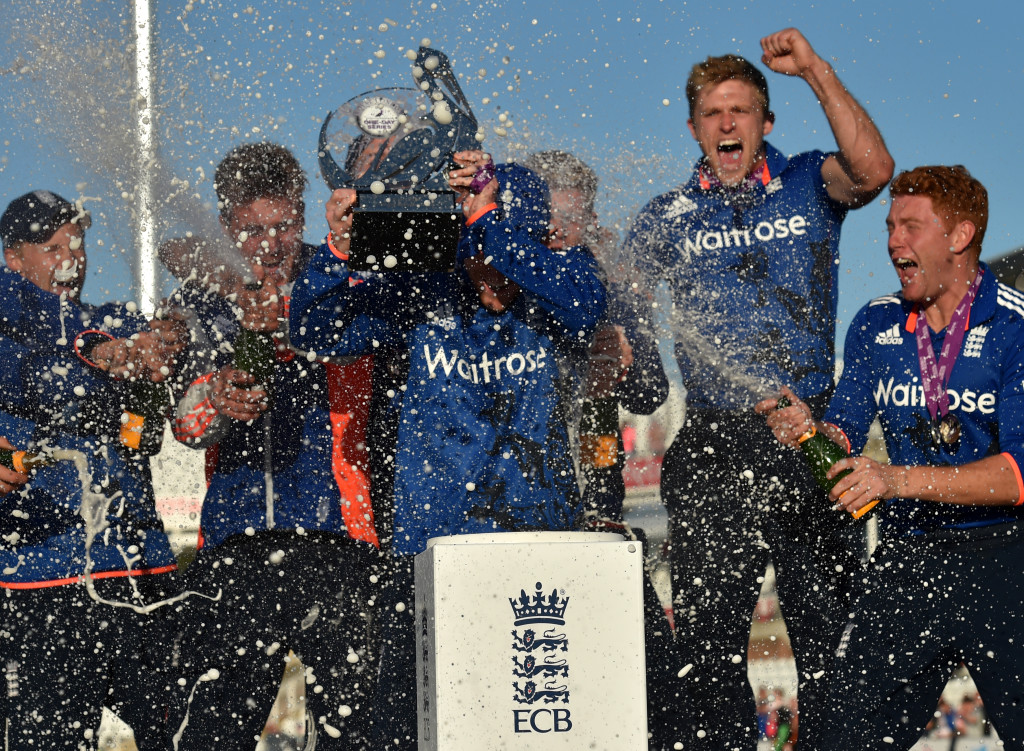England’s recent performances against New Zealand across all three formats showed signs of exciting progress, but with series against Australia and South Africa approaching, turning progress into consistency will be their toughest challenge yet, writes Tom Sizeland.
What a difference a few months can make. Eoin Morgan’s England side cut a forlorn unit when they walked away from the Adelaide Oval on 9 March, as defeat to Bangladesh spelled the end of their World Cup campaign at the group stages.
A plethora of doubt and confusion swept over the future of English cricket, as an underwhelming Test series against West Indies preceded an even more underwhelming plan outline from new director of English cricket Andrew Strauss.
Kevin Pietersen’s continued omission from the plans dominated the public and professional mutterings. And while Strauss discussed his intent to get a new coach in time for the Ashes, you could be forgiven for forgetting that a month-long visit from the potent, world-cup finalist-New Zealanders loomed large.
While this was going on, caretaker coach Paul Farbrace was indeed busy preparing his side to face what many labeled the strongest New Zealand side to have ever toured the UK.
Come day one of the first Test match, it was an all too familiar sight. The media had their pens and voices ready to rip into the staff on and off the field, while the reverberations of Pietersen’s smug smile could be felt across Lord’s. England reeled on 30-4, before trailing by 134 runs going into their second innings.
England’s stifled and mediocre game looked set to continue, until one man, controversially omitted from World Cup selection, decided to rewrite the script completely. On day four, Ben Stokes struck the quickest Test century ever at Lord’s. The atmosphere changed. The spectators found their voice and the players found their vigour. You could go as far as saying that the fickle English public fell back in love with cricket in one session. England turned the tables and won the match by 124 runs.
New Zealand would go on to win the next match by 199 runs, but the joys of Stokes’ marvel in the first Test match swamped any disappointment accrued from the second, and it transcended to what turned out to be one of the most enthralling ODI series in recent history. It was in the 50-over series where England can truly look back and say things have progressed.
As if out of nowhere, they scored their highest ever total and secured their highest ever successful chase in a matter of days.
Ironically, though, it was when they went 2-1 down in the series that the new England précis became clear. England were bowled out for 302 in 45 overs, before the tourists chased it down with an over to spare. ‘It didn’t matter that we got bowled out,’ said Farbrace. ‘We got past 300 playing the cricket we wanted to play.’
‘Sometimes it might not come off, but when we do play that way we win matches,’ added skipper Morgan, who made four ducks in eight ODI innings before the series, but struck four fifties in five innings against the Black Caps – repaying the faith Strauss put in him to continue the captaincy. They went on to win the next two ODI games and the one-off T20i, and with that, two series.
A lot of credit must go to the way New Zealand played too, and if it wasn’t for the disappointing form of Brendon McCullum, whose expectations to perform have dramatically increased in recent times, things might have been different. Their displays at the World Cup proved they play without fear and with respect, and it’s no secret that the English have been inspired by that, who as a collective, clearly decided that their failed displays in the showpiece in Australasia, was the final straw.
‘We have already seen our limited-overs cricket begin to move in the right direction which is exciting but we are all aware that we have plenty more to do if we are going to challenge the very best sides in the world on a regular basis,’ said James Whittaker.
This is a fair assessment from England’s national selector, as a gruelling schedule awaits, which includes nine Tests, 10 ODIs and three T20s against almost unarguably cricket’s two finest sides, Australia and South Africa.
Joe Root, Jos Buttler and Ben Stokes are the only Test shoo-ins from the limited over sides, but that doesn’t mean they can’t infect the five-day side with the spirit shown from their recent triumphs.
Let’s not forget that England drew their Test series with West Indies and New Zealand, and they’ve only won one of their last five Test series, but there is a strong feeling that the way they approached the ODIs can be used as leverage for the Tests. England fans will hope that the way Stokes played in that first Test is merely a glimpse of what is to come.
Much will depend on how the key men missing from the ODI series (James Anderson, Stuart Broad and Alistair Cook) and incoming coach Trevor Bayliss will take to the invigorated, revamped mind-set created from Farbrace’s limited overs players. Renowned cricket pundit Jonathan Agnew said ‘I think they will have a feel for what’s happened here, and be very energised by how England have played.’
Root hit the nail on the head.
‘Everyone has gone out this summer with a freedom and it’s really refreshing to see everyone commit to it and absolutely go for it. The way we are playing we want to keep developing and improving. We’ve had a really good start to the summer with all that. We have some important cricket coming up and it is really exciting.’
Speaking before New Zealand’s tour, Steven Smith said of England’s chances: ‘I don’t think that they’ll come close to us to be honest.’
Exciting cricket won’t necessarily get you results, but the attitude they portrayed in the ODIs will be key to combating the ruthless Aussies, and if Bayliss, Cook and even Strauss can buy into it, Smith might be forced to eat his words.







